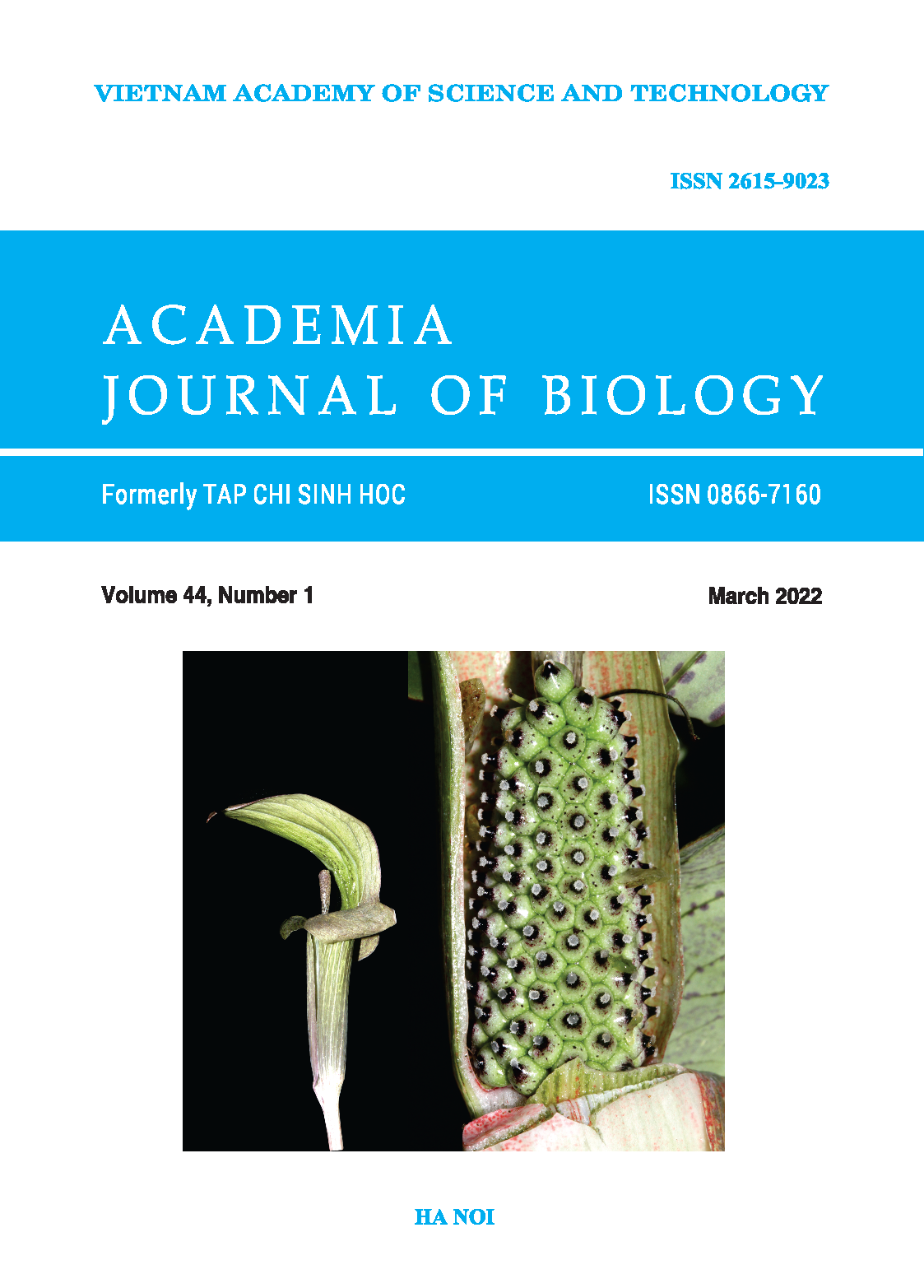DNA barcodes in identification of some species of hawkmoths (Lepidoptera: Sphingidae)
Author affiliations
DOI:
https://doi.org/10.15625/2615-9023/15742Keywords:
DNA, cytochrome c oxidase I (COI), Cechetra, Sphingidae, hawkmoths.Abstract
The use of DNA barcodes is a molecular method commonly used for the identification of specimens that are difficult to pinpoint accurately by traditional morphological methods. DNA barcoding uses standard short genomic regions that are universally present in target lineages and has sufficient sequence variation to identify species in the genus. The hawkmoth genus Cechetra (Zolotuhin & Ryabov, 2012) was proposed for a group of morphologically similar, stripe-patterned species. Based on the seven specimens of the three species of Cechetra genus collected from the Central of Vietnam, we used morphological analysis to initially identified their scientific name of Cechetra lineosa (Walker, 1856) for 04 specimens (LB_F01, LB_G01, LB_H01 and LK_G05); 02 specimens (MK_H04 and MK_B07) were identified with the scientific name of Cechetra minor (Butler, 1875) and 01 specimen (SG_D7) with scientific name Cechetra subangustata (Rothschild, 1920). Then, the COI (Cytochrome C oxidase I) sequence was used for molecular analysis. Total DNA was extracted from the legs of specimens, COI with over 600 bp in length from each specimen was amplified by PCR reactions. The PCR products are hence purified and sequenced. COI gene cloning results showed a very high level of genetic similarity (over 99%) and 7 specimens are of the genus Cechetra, Sphingidae family. For three homomorphic species belonging to the genus Cechetra Zolotuhin & Ryabov, 2012 including Cechetra lineosa (Walker, 1856); Cechetra minor (Butler, 1875) and Cechetra subangustata (Rothschild, 1920). The studied sequences have been added to the current database at GenBank (NCBI) with accession numbers MT994230, MT994231, MT994232, MT994233, MT994234, MT994235, and MT994236.
Downloads
References
Barcode of Life Data System, 2020. https://www.boldsystems.org/. Date accessed: 11/9/2020.
Clarkston B. E., Saunders G.W., 2010. A comparison of two DNA barcode markers for species discrimination in the red algal family Kallymeniaceae (Gigartinales, Florideophyceae), with a description of Euthora timburtonii sp. nov.. Botany, 88(2): 119–131.
Folmer O. M., Black W., Hoen R., Lutz R., Vrijenhoek R., 1994. DNA primers for amplification of mitochondrial cytochrome c oxidase subunit I from diverse metazoan invertebrates. Molecular Marine Biology and Biotechnology, 3: 294–299.
Foottit R. G., Maw H. E. L. , Dohlen von C. D., Hebert P. D. N., 2008. Species identification of aphids (Insecta: Hemiptera: Aphididae) through DNA barcodes. Molecular Ecology Resources, 8:1189–1201.
Hastings JM, Schultheis PJ, Whitson M., 2008. DNA barcoding of new world cicada killers (Hymenoptera: Crabronidae). Zootaxa, 1713: 27–38.
Hebert P. D. N. , Cywinska A., Ball S. L., deWaard J. R., 2003a. Biological identifications through DNA barcodes. Proceedings of the Royal Society of London, Series B. Biological Sciences, 270: 313–321.
Hebert P. D. N. , Ratnasingham S., deWaard J. R., 2003b. Barcoding animal life: cytochrome c oxidase subunit 1 divergences among closely related species. Proceedings of the Royal Society of London, Series B. Biological Sciences, 270(Suppl): S96–S99.
Holloway, J. D., Kibby, G. & Peggie, D., 2001. The families of Malesian moths and butterflies. Fauna Malesiana 3, i–xi, 1–455. Brill, Leiden, Boston & Köln.
Hou Z. E., Li Z., Li S. Q., 2009. Identifying Chinese species of Gammarus (Crustacea: Amphipoda) using DNA barcoding. Current Zoology. 2009; 55:158–164.
Hubert N., Hanner R., Holm E., Mandrak N. E, Taylor E., Burridge M., Watkinson D., Dumont P., Curry A., Bentzen P., Zhang J., April J., Bernatchez L., 2008. Identifying Canadian fresh water fishes through DNA barcodes. PLoS one, 3: e2490.
Kitching I. J., 2020. Sphingidae Taxonomic Inventory. Available from: http://sphingidae.myspecies.info/ (accessed on 20 November 2020).
Kitching I. J., Cadiou J. M., 2000. Hawkmoths of the World: An Annotated and Illustrated Revisionary Checklist (Lepidoptera: Sphingidae). Cornell University Press, pp. 256.
Kumar S., Stecher G., Tamura K., 2016. MEGA7: Molecular evolutionary genetics analysis version 7.0 for bigger datasets. Mol. Biol. Evol., 33(7): 1870–1874.
Nicholas K. B, Nicholas H. B, Deerfield D. W., 1997. GeneDoc: Analysis and visualization of genetic variation. Embnew news 4, pp. 14.
Tavares E. S., Baker A. J., 2008. Single mitochondrial gene barcodes reliably identify sister-species in diverse clades of birds. BMC Evolutionary Biology, 8: 81.
Thompson J. D., Gibson T. J., Plewniak F., Jeanmougin F., Higgins D. G., 1997. The CLUSTAL_X windows interface: flexible strategies for multiple sequence alignment aided by quality analysis tools. Nucleic Acids Res., 25: 4876–4882.
Wong E., Shivji M. S., Hanner R. H., 2009. Identifying sharks with DNA barcodes: assessing the utility of a nucleotide diagnostic approach. Molecular Ecology Resources, 9 (Suppl. 1): 243–256.
Websize: http://www.ncbi.nlm.nih.gov. (September 09, 2020).
Zolotuhin V. V. and Ryabov S. A., 2012. The hawk moths of Vietnam. Ulyanovsk Publishing House, pp. 236.
Downloads
Published
How to Cite
Issue
Section
License
Academia Journal of Biology (AJB) is an open-access and peer-reviewed journal. The articles published in the AJB are licensed under a Creative Commons Attribution-NonCommercial-NoDerivatives 4.0 International License (CC BY-NC-ND 4.0), which permits for immediate free access to the articles to read, download, copy, non-commercial use, distribution and reproduction in any medium, provided the work is properly cited (with a link to the formal publication through the relevant DOI), and without subscription charges or registration barriers. The full details of the CC BY-NC-ND 4.0 License are available at https://creativecommons.org/licenses/by-nc-nd/4.0/.












